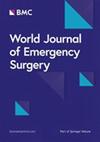穿孔性消化性溃疡疾病的规模、结局和死亡率预测因素:埃塞俄比亚吉吉加镇的一项回顾性研究
IF 5.8
1区 医学
Q1 EMERGENCY MEDICINE
引用次数: 0
摘要
消化性溃疡穿孔(PUP)是影响2-10%消化性溃疡(PUD)患者的外科急诊和危及生命的并发症。延迟诊断和手术治疗与显著的发病率和死亡率相关。本研究评估了在埃塞俄比亚吉吉格镇两家公立医院接受手术的患者的PUP程度和结果。对2018年4月1日至2021年7月30日在吉吉市研究医院接受PUP手术的130例患者进行了为期3年的回顾性横断面研究。数据是从医疗记录中收集的。双变量分析确定了影响PUP患者预后的关键因素。该队列的男女比例为8.7:1,平均年龄为38±13.3岁,吸烟者占48.8%,咀嚼者占56.6%。十二指肠穿孔占93.7%,术后并发症29.1%,住院死亡率5.5%。发病率和死亡率的重要预测因素包括高龄(AOR 23.88)、合并症(AOR 26.80)、术前低血压(AOR 32.33)和延迟入院(AOR 30.10)。在穿孔性消化性溃疡病例中,男性居多,年轻,吸烟和咀嚼率高,主要是十二指肠穿孔是常见的。高龄、合并症、术前低血压和住院时间延迟显著增加了术后并发症和死亡率,强调需要及时干预和有针对性的公共卫生措施来改善患者的预后。早期干预和仔细管理合并症对于提高PUP患者的生存率和减少并发症至关重要。本文章由计算机程序翻译,如有差异,请以英文原文为准。
Magnitude, outcome, and predictors of mortality in perforated peptic ulcer disease: a retrospective study in Jigjiga town, Ethiopia
Peptic ulcer perforation (PUP) is a surgical emergency and life-threatening complication affecting 2–10% of peptic ulcer disease (PUD) patients. Delayed diagnosis and surgical management are associated with significant morbidity and mortality. This study assessed the magnitude and outcome of PUP among patients operated on at two public hospitals in Jigjig town, Ethiopia. A 3-year hospital-based retrospective cross-sectional study was conducted on 130 patients operated for PUP at the study hospitals in Jigjig from April 1st, 2018, to July 30th, 2021. Data were collected from medical records. Bivariate analysis identified key factors impacting outcomes in PUP patients. The cohort had a male-to-female ratio of 8.7:1, and a mean age of 38 ± 13.3 years, with 48.8% smokers and 56.6% chat chewers. Duodenal perforations accounted for 93.7% of cases, with post-operative complications in 29.1% and an in-hospital mortality rate of 5.5%. Significant predictors of morbidity and mortality included advanced age (AOR 23.88), comorbidities (AOR 26.80), pre-operative hypotension (AOR 32.33), and delayed hospital presentation (AOR 30.10). Male predominance, younger age, high smoking and chat chewing rates, and primarily duodenal perforations are common in perforated peptic ulcer cases. Advanced age, comorbidities, pre-operative hypotension, and delayed hospital presentation significantly increase postoperative complications and mortality, emphasizing the need for timely intervention and targeted public health measures to improve patient outcomes. Early intervention and careful management of comorbidities are crucial to improve survival and reduce complications in patients with PUP.
求助全文
通过发布文献求助,成功后即可免费获取论文全文。
去求助
来源期刊

World Journal of Emergency Surgery
EMERGENCY MEDICINE-SURGERY
CiteScore
14.50
自引率
5.00%
发文量
60
审稿时长
10 weeks
期刊介绍:
The World Journal of Emergency Surgery is an open access, peer-reviewed journal covering all facets of clinical and basic research in traumatic and non-traumatic emergency surgery and related fields. Topics include emergency surgery, acute care surgery, trauma surgery, intensive care, trauma management, and resuscitation, among others.
 求助内容:
求助内容: 应助结果提醒方式:
应助结果提醒方式:


